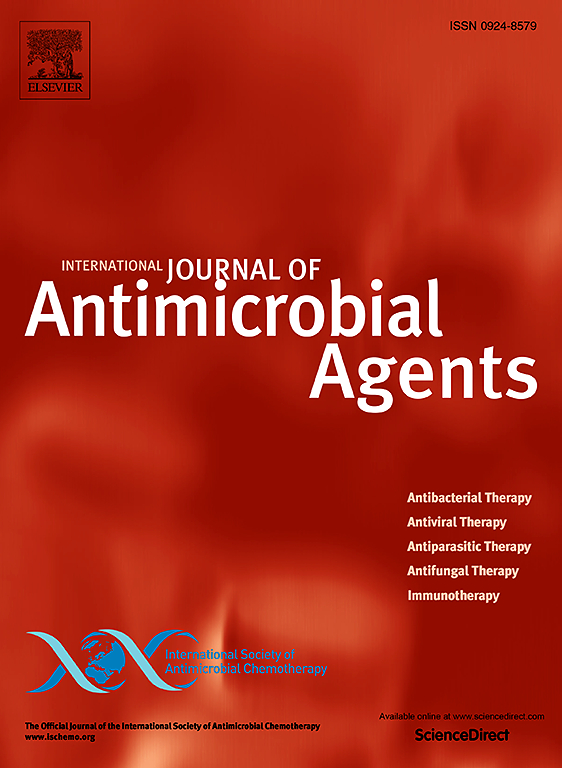Multiomics informed mathematical model for meropenem and tobramycin against hypermutable Pseudomonas aeruginosa
IF 4.9
2区 医学
Q1 INFECTIOUS DISEASES
International Journal of Antimicrobial Agents
Pub Date : 2025-03-07
DOI:10.1016/j.ijantimicag.2025.107488
引用次数: 0
Abstract
Background
Hypermutable P. aeruginosa isolates frequently display resistance emergence during treatment. Mechanisms of such resistance emergence have not been explored using dynamic hollow-fiber studies and multiomics informed mathematical modeling.
Methods
Two hypermutable and heteroresistant P. aeruginosa isolates, CW8 (MICmeropenem=8 mg/L, MICtobramycin=8 mg/L) and CW44 (MICmeropenem=4 mg/L, MICtobramycin=2 mg/L), were studied. Both isolates had genotypes resembling those of carbapenem- and aminoglycoside-resistant strains. Achievable lung fluid concentration-time profiles following meropenem at 1 or 2 g every 8 h (3-h infusion) and tobramycin at 5 or 10 mg/kg body weight every 24 h (0.5-h infusion), in monotherapy and combinations, were simulated over 8 days. Total and resistant bacterial counts were determined. Resistant colonies and whole population samples at 191 h were whole-genome sequenced, and population transcriptomics performed at 1 and 191 h. The multiomics analyses informed mechanism-based modeling of total and resistant populations.
Results
While both isolates eventually displayed resistance emergence against all regimens, the high-dose combination synergistically suppressed resistant regrowth of only CW8 up to ∼96 h. Mutations that emerged during treatment were in pmrB, ampR, and multiple efflux pump regulators for CW8, and in pmrB and PBP2 for CW44. At 1 h, mexB, oprM and ftsZ were differentially downregulated in CW8 by the combination. These transcriptomics results informed inclusion of mechanistic synergy in the mechanism-based model for only CW8. At 191 h, norspermidine genes were upregulated (without a pmrB mutation) in CW8 by the combination, and informed the adaptive loss of synergy in the model.
Conclusion
Multiomics information enabled mechanism-based modeling to describe the bacterial response of both isolates simultaneously.
Importance
Pseudomonas aeruginosa causes serious bacterial infections in people with cystic fibrosis (pwCF), and has numerous resistance mechanisms. Current empirical approaches to informing antibiotic regimen selection have important limitations. This study exposed two P. aeruginosa clinical isolates to concentration-time profiles of meropenem and tobramycin as would be observed in lung fluid of pwCF. The combination elicited different bacterial count profiles between the isolates, despite similar bacterial baseline characteristics. We found differences between the isolates in the expression of a key resistance mechanism against meropenem at 1 h, and expression that implied a loss of cell membrane permeability for tobramycin without the expected DNA mutation. This information enabled mathematical modeling to accurately describe all bacterial profiles over time. For the first time, this multiomics informed modeling approach using DNA and RNA data was applied to a hollow-fiber infection study. Using bacterial molecular insights with mechanism-based mathematical modeling has high potential for ultimately informing personalised antibiotic therapy.

多组学建立了美罗培南和妥布霉素抗超变铜绿假单胞菌的数学模型。
超可变铜绿假单胞菌分离株在治疗期间经常出现耐药性。这种抗性出现的机制尚未利用动态中空纤维研究和多组学信息的数学模型进行探索。对铜绿假单胞菌CW8 (MICmeropenem=8mg/L, MICtobramycin=8mg/L)和CW44 (MICmeropenem=4mg/L, MICtobramycin=2mg/L)两株高变异耐药菌株进行了研究。两株菌株的基因型与碳青霉烯类和氨基糖苷类耐药菌株相似。在单药治疗和联合治疗中,美罗培南每8小时1或2g(3小时输注)和妥布霉素每24小时5或10mg/kg体重(0.5小时输注)可达到的肺液浓度-时间曲线在8天内进行模拟。测定总细菌数和耐药细菌数。对抗性菌落和191h的整个群体样本进行全基因组测序,并在1和191h进行群体转录组学。多组学分析为总种群和抗性种群的基于机制的建模提供了信息。虽然两种分离株最终对所有治疗方案都表现出耐药性,但高剂量联合治疗仅协同抑制CW8的耐药再生长达96小时。在治疗期间出现的突变是在CW8的pmrB、ampR和多个外排泵调节因子中,以及CW44的pmrB和PBP2中。1h时,联合用药使CW8中mexB、oprM和ftsZ差异下调。这些转录组学结果表明,在基于机制的模型中仅包含CW8的机制协同作用。19h时,去亚精胺基因在CW8中被组合上调(无pmrB突变),并告知模型中协同作用的适应性丧失。多组学信息使基于机制的建模能够同时描述两种分离株的细菌反应。重要性:铜绿假单胞菌在囊性纤维化(pwCF)患者中引起严重的细菌感染,并具有多种耐药机制。目前的经验方法告知抗生素方案的选择有重要的局限性。本研究将两个铜绿假单胞菌临床分离株暴露于美罗培南和妥布霉素的浓度-时间谱中,这将在pwCF的肺液中观察到。尽管细菌基线特征相似,但这种组合在分离物之间引起了不同的细菌计数谱。我们发现,两株菌株在1小时时对美罗培南的一种关键耐药机制的表达存在差异,这种表达意味着妥布霉素的细胞膜通透性丧失,而没有预期的DNA突变。这些信息使数学模型能够准确地描述所有细菌随时间变化的特征。这种利用DNA和RNA数据的多组学建模方法首次应用于空心纤维感染研究。利用细菌分子的见解与基于机制的数学模型具有很高的潜力,最终为个性化抗生素治疗提供信息。
本文章由计算机程序翻译,如有差异,请以英文原文为准。
求助全文
约1分钟内获得全文
求助全文
来源期刊
CiteScore
21.60
自引率
0.90%
发文量
176
审稿时长
36 days
期刊介绍:
The International Journal of Antimicrobial Agents is a peer-reviewed publication offering comprehensive and current reference information on the physical, pharmacological, in vitro, and clinical properties of individual antimicrobial agents, covering antiviral, antiparasitic, antibacterial, and antifungal agents. The journal not only communicates new trends and developments through authoritative review articles but also addresses the critical issue of antimicrobial resistance, both in hospital and community settings. Published content includes solicited reviews by leading experts and high-quality original research papers in the specified fields.

 求助内容:
求助内容: 应助结果提醒方式:
应助结果提醒方式:


